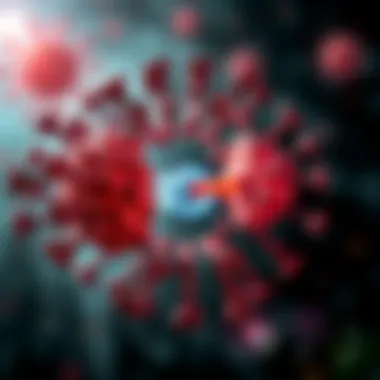Exploring the BCG Vaccine for Bladder Cancer Treatment


Intro
The landscape of cancer treatment is ever-evolving, and one area garnering significant attention involves repurposing existing vaccines. Among these, the Bacillus Calmette-Guérin (BCG) vaccine stands out for its intriguing application in bladder cancer therapy. Originally formulated to combat tuberculosis, BCG’s journey into oncology opens a dialogue about innovation and the potential for crossover benefits in medicine.
This intersection of vaccine technology and cancer treatment is pertinent for researchers, clinicians, and students exploring novel therapeutic avenues. The subsequent sections of this article will delve deep into the specifics of how BCG operates within the context of bladder cancer, elaborating on key findings and implications of this fascinating overlap.
Many patients diagnosed with bladder cancer find themselves with few options, and the incorporation of BCG into treatment protocols signifies a beacon of hope. From its historical roots to the contemporary implications of its use, the exploration of BCG will be structured to provide a well-rounded understanding of its role in immunotherapy, and most importantly, how it can influence patient outcomes.
Next, we will only focus on the pivotal highlights that encapsulate the essence of current research in this domain, ensuring that all insights and data presented here serve the dual purpose of informing and sparking further investigation into this promising area of study.
From the mechanisms of action to ongoing research efforts, come along as we map out the complex yet rewarding path of the BCG vaccine in treating bladder cancer.
Preface
The exploration of Bacillus Calmette-Guérin (BCG) vaccine, initially designed to combat tuberculosis, has begun to unveil a transformative potential in the realm of bladder cancer treatment. Understanding this relationship is not just an academic exercise; it holds crucial implications for medical practice and patient outcomes. In this section, we’ll delve into the significance of this crossover, highlighting the benefits of adapting a historical vaccine for modern oncological challenges and the intricacies involved in such a transition.
Context of Bladder Cancer
Bladder cancer, one of the most prevalent types of cancer worldwide, presents unique challenges in diagnosis and treatment. The disease often manifests in a multifocal manner, which means it can appear at multiple sites within the bladder. Furthermore, it recurs at high rates, making effective management essential. Common treatment options include surgical interventions combined with chemotherapy or immunotherapy, but many patients face side effects or resistance to these modalities. This scenario leads researchers to seek alternative strategies, like the BCG vaccine, that could offer more sustainable solutions.
Recent studies have shown that about 75% of patients diagnosed with superficial bladder cancer will experience relapse within five years. With advancements in immunotherapy, the BCG vaccine stands out as a beacon of hope, transforming the landscape of treatment protocols. Its historical use against a infectious disease could provide insights into a fresh approach in combating bladder cancer, thereby highlighting the urgent need to evaluate its role in the future management of this challenging condition.
Overview of Tuberculosis Vaccines
The Bacillus Calmette-Guérin vaccine, developed in the early 20th century, was a groundbreaking achievement in the fight against tuberculosis—the infectious disease that claimed millions of lives worldwide. This vaccine represents one of the first successful examples of live attenuated bacterial immunization. Its mechanisms involve stimulating the immune system to recognize and attack Mycobacterium tuberculosis, the bacterium responsible for the disease.
The connection between the BCG vaccine and bladder cancer treatment stems from its ability to evoke a robust immune response. When instilled into the bladder, BCG triggers localized inflammation and activates immune cells, creating an inhospitable environment for tumor growth.
"The repurposing of historical vaccines opens a dialogue between infectious disease management and cancer therapy, challenging conventional boundaries and assumptions."
Thus, the BCG vaccine not only adds a layer of complexity to our understanding of immunology but also reinforces the idea that innovations in vaccine technology can pave new paths in oncological strategies. Recognizing the dual role of BCG as both a preventative and therapeutic agent could reshape treatment paradigms for bladder cancer, encouraging a synthesis that must be closely examined as ongoing research unfolds.
This introduction sets the stage for diving deeper into the nuances of BCG's development, mechanisms, and subsequent clinical experiences, illuminating a path that could benefit numerous bladder cancer patients worldwide.
Historical Perspective on BCG Vaccine
The historical significance of the Bacillus Calmette-Guérin (BCG) vaccine cannot be overstated. As researchers dive deep into the potential uses of the BCG vaccine, particularly in the field of bladder cancer treatment, it is crucial to understand the vaccine's background. This knowledge helps frame discussions about its efficacy, mechanisms, and the ongoing challenges in its application. Moreover, the historical journey of BCG offers insights into both its initial purpose and unintended yet monumental advancements in the treatment of other diseases, notably bladder cancer.
Development of the BCG Vaccine
The BCG vaccine was birthed in a period rife with urgency and innovation. Developed in the 1920s by Albert Calmette and Camille Guérin, the vaccine aimed to combat tuberculosis during an era when the disease ran rampant across continents. The duo cultivated a strain of Mycobacterium bovis, attenuating its virulence. The primary goal was clear: create a vaccine that would reduce tuberculosis infections and save lives. Despite initial skepticism and challenges in its rollout, BCG had become a significant milestone in infectious disease prevention.
As years passed, the unexpected immunotherapeutic properties of BCG began to emerge. In the late 1970s, physicians started to note its effectiveness in treating non-muscle invasive bladder cancer. This discovery was akin to finding a diamond in a rough; something valuable emerged from a tool designed for an entirely different purpose. The notion that a vaccine, rooted in the fight against tuberculosis, could also be instrumental against cancer transformed how medical professionals approached treatment protocols.
Early Applications and Use Cases
The early applications of the BCG vaccine in bladder cancer treatment revealed a transformative potential. Trials began in the 1980s, highlighting that the vaccine could instigate an immune response calibrated to combat cancer cells. The premise was simple yet elegant: use the body’s own immune system to fight cancer. In fact, BCG became not just an option, but a significant standard of care for certain types of bladder cancer.
In clinical settings, the results were promising. Many patients showed significant tumor regression, with some achieving complete remission. The mechanism behind this was believed to lie in the immune response activation, where BCG acts akin to a fire alarm in the body, prompting the immune system to respond to the perceived threat of cancerous cells as if they were pathogens.
“The introduction of BCG into bladder cancer therapy is a testament to the versatility of medicinal interventions; what was once merely a preventative measure against tuberculosis has evolved into a viable cancer treatment.”
Moreover, the applications of BCG have expanded over the years. The regimen's flexibility allows it to be administered intravesically, ensuring localized treatment with minimal systemic toxicity. Thus far, it remains a cornerstone in urology, illustrating how historical medical innovations can pivot towards unforeseen applications, offering hope where once there seemed to be none.
The lessons gleaned from the historical perspective of the BCG vaccine underscore the importance of adaptability in medical research. As we push forward in exploring further applications of the vaccine, it serves as a beacon of inspiration—reminding us that sometimes, answers come from the most unexpected of places.


Mechanisms of Action of BCG in Cancer Treatment
The mechanisms by which the Bacillus Calmette-Guérin (BCG) vaccine operates in the realm of cancer treatment are fascinating and pivotal in understanding how an ostensibly simple vaccine can yield significant therapeutic benefits, especially in bladder cancer. This section delves into how BCG stimulates the immune system, modifies the tumor microenvironment, and why these actions are essential for enhancing the efficacy of cancer therapies.
Immune Response Activation
One of the standout features of the BCG vaccine is its interaction with the immune system. When BCG is administered intravesically for bladder cancer, it sparks a robust immune response. This response primarily involves the activation of T-cells and macrophages, which play crucial roles in targeting and eliminating cancer cells.
Let’s break it down:
- T-cell Activation: BCG encourages T-cells to recognize malignant cells. These immune defenders seek out and destroy bladder cancer cells, particularly those cells that pose the highest threat.
- Macrophage Recruitment: The vaccine boosts macrophage activity. These white blood cells not only engulf tumor cells but also release cytokines and chemokines. These signaling proteins amplify the immune response and help to recruit additional immune cells to the tumor site.
Research indicates that this immune activation is more than just a temporary flare-up. It can change how the cancer microenvironment operates. A more hostile environment for tumor cells also means a safer one for normal cells.
"The immune system can be likened to a well-trained army—BCG just gives it the orders to charge at cancer!"
Understanding how BCG triggers and modulates immune activity opens doors to potential combination therapies, where traditional cancer treatments, like chemotherapy, can be integrated to provide broader therapeutic approaches.
Tumor Microenvironment Modification
What makes the tumor microenvironment in bladder cancer peculiar is the interplay between cancer cells and the surrounding cellular milieu. BCG does not just attack cancer cells; it alters the landscape of the tumor itself, creating conditions that are unfavorable for tumor growth.
The way BCG modifies this environment involves:
- Inhibition of Angiogenesis: BCG may reduce the formation of new blood vessels, a process known as angiogenesis. Without a reliable blood supply, tumor cells struggle to grow and proliferate.
- Stimulation of Cytokine Release: When BCG is introduced, it stimulates the production of various cytokines, including interleukin-2 (IL-2) and tumor necrosis factor-alpha (TNF-α). These cytokines can inhibit tumor growth and promote the immune response.
- Alteration of Tumor Cell Phenotype: The vaccine can force malignant cells to undergo a form of transformation, making them more recognizable to the immune system.
This modification of the tumor microenvironment ultimately creates a hostile atmosphere for cancer proliferation. The resilient tumor cells that once thrived there may find themselves unable to survive against the now invigorated and vigilant immune system. It’s like turning a vibrant city into a deserted battleground—a place where cancer cells are outnumbered and overpowered.
BCG’s multifaceted mechanisms reinforce the notion that effective cancer treatments must leverage both direct targeting of tumor cells and indirect strategies that alter the broader environment in which these cells exist.
Clinical Efficacy of BCG for Bladder Cancer
The use of the Bacillus Calmette-Guérin (BCG) vaccine for the treatment of bladder cancer has opened new avenues in oncology. It is essential to understand its efficacy not just as a therapy but as a game changer in how we approach this specific type of cancer.
BCG's mechanisms of action extend beyond its initial design against tuberculosis. The efficacy in bladder cancer treatment can be attributed to its ability to stimulate the immune system. By enhancing immune responses specifically targeting bladder tumor cells, BCG serves both as a vaccine and a sort of immune booster. This dual role is a key point of interest in the ongoing research aimed at refining its application.
Treatment Protocols and Administration
The standard regimen for BCG treatment involves several intravesical administrations, where the vaccine is instilled directly into the bladder. Typically, patients receive weekly treatments over a period of six weeks, followed by maintenance therapy that can last for several years. This approach maximizes the local immune response by concentrating the BCG where it is needed the most — within the bladder.
- Initial Treatment Protocol: 6 weekly instillations of BCG
- Maintenance Therapy: Administered after the initial phase, varies by protocol but often occurs every 3 to 6 months for up to three years.
The treatment procedure is generally tolerable, yet it requires close monitoring due to the possibility of complications, especially concerning bladder irritation. Understanding these protocols is crucial as they form the backbone of the clinical efficacy research surrounding BCG.
Outcomes and Survival Rates
The clinical outcomes of BCG therapy for superficial bladder cancer reveal promising data. Studies indicate that approximately 70% of patients respond positively to initial treatment, with many achieving remission. Moreover, when looking into long-term survival rates, BCG-treated individuals often have a significantly lower rate of recurrence compared to those not treated with the vaccine.
- Complete Response Rate: Approximately 70%
- Recurrence Reduction: 30-50% reduction in recurrence over five years compared to other treatments.
This impressive efficacy has led many oncologists to favor BCG as the first-line treatment for high-risk superficial bladder cancer. However, the variability in outcomes based on disease stage and patient characteristics highlights the need for personalized treatment plans.
Side Effects and Complications
While BCG is heralded for its efficacy, it is crucial to address the potential side effects and complications that accompany its use. The most common adverse effects are generally mild and can include:
- Urgency and frequency of urination
- Hematuria (blood in urine)
- Bladder irritation


These side effects may range from mildly uncomfortable to quite bothersome for some patients. More severe complications, though rare, can occur, including systemic reactions that necessitate immediate medical attention. It is vital for healthcare providers to inform patients about these risks and monitor them throughout the treatment process. Educating patients about what to expect from BCG therapy contributes to better management of side effects and improves adherence to treatment protocols.
"Educated patients are empowered patients. Understanding the treatment landscape is essential for a successful therapeutic journey."
Current Research Trends
Research into the Bacillus Calmette-Guérin (BCG) vaccine is advancing rapidly, taking avenues that could reshape its application in treating bladder cancer. As the landscape of cancer treatment evolves, staying ahead of current research trends becomes vital. This section dissects the latest developments, elucidating ongoing clinical trials and innovations in vaccine formulation, both of which hold the promise of enhancing efficacy and accessibility.
Ongoing Clinical Trials
The importance of ongoing clinical trials cannot be overstated. They serve as the backbone of scientific inquiry, investigating new hypotheses and confirming existing knowledge. Currently, various clinical trials are exploring the application of BCG in a more targeted manner, aiming to address the limitations found in earlier treatments.
- Diverse Populations: Trials are increasingly focusing on including diverse populations to ensure findings are universally applicable.
- Dosage Optimization: Some studies are experimenting with varying dosages of BCG to determine which regimens yield the best results with least side effects, recognizing that a one-size-fits-all approach may not be valid in cancer treatment.
- Combination Therapies: There’s a significant trend toward assessing BCG in combination with other therapies, like immune checkpoints inhibitors and novel chemotherapeutics. The idea is to harness BCG's immune-modulating effects in conjunction with more conventional modalities.
"The integration of BCG with other treatments could potentially amplify its therapeutic effects, offering hope to patients who have not responded to standard therapies."
These trials are not just about immediate outcomes but also about understanding long-term impacts. Patient quality of life, recurrence rates, and overall survival are key indicators researchers are tracking. Each result adds a piece to the broader puzzle of how BCG can be adapted to meet tomorrow's challenges in oncology.
Innovations in Vaccine Formulation
As researchers delve deeper into how BCG can be fine-tuned, innovations in vaccine formulation are also at the forefront. It's not merely about using BCG; it's about enhancing its effectiveness and targeting capability. Some key innovative aspects being explored include:
- Sustained Release Formulations: Scientists are working on creating slow-release formulations that allow for prolonged exposure of the cancer site to BCG, thereby maximizing its impact.
- Adjuvant Technologies: The integration of adjuvants—substances that enhance the body's immune response—into BCG formulations is under investigation. These could potentially bolster the immune system’s reaction to the vaccine, making it more effective against tumor cells.
- Genetic Modifications: Researchers are also exploring genetically modified strains of BCG that might elicit a stronger immune response, focusing on cancer-specific antigens to drive home the attack on bladder cancer cells.
This wave of innovations is not just focused on improving outcomes; they directly address complications and side effects faced by previous BCG treatments. By optimizing the formulation, it is possible to reduce the adverse reactions associated with BCG therapy, making it a safer option for patients.
In pairing these two significant trends, the research community is seeking to pioneer a future where BCG isn't simply a historical relic but a continually evolving therapeutic tool that plays a critical role in managing bladder cancer more effectively.
Challenges in BCG Therapy for Bladder Cancer
The use of the Bacillus Calmette-Guérin (BCG) vaccine as a treatment for bladder cancer is indeed groundbreaking, yet it does not come without hurdles. Understanding these challenges is essential for anyone involved in the management and treatment of this prevalent cancer. BCG therapy, while promising, faces complications that can impact its effectiveness and accessibility. The importance of delving into these challenges lies not just in identifying problems, but also in finding potential solutions that can enhance the therapeutic benefit of the vaccine.
Treatment Resistance
One of the major obstacles when using BCG therapy in bladder cancer treatment is the phenomenon of treatment resistance. While BCG has been shown to be effective in many patients, certain individuals develop a resistance that diminishes the treatment's efficacy. The immune system's intricacies can be baffling, and why some patients respond positively while others do not often remains unclear.
Several factors contribute to treatment resistance, including:
- Tumor Characteristics: The biological makeup of the tumor, including its genetic mutations and the tumor mist of its microenvironment, can influence the treatment resilience.
- Prior Treatments: Patients who have undergone other therapies may display altered immune responses, affecting how well BCG works for them.
- Immune Status: The overall health and immune status of a patient also play an undeniable role. Those with weakened immune systems may not mount a strong enough response to the vaccine.
Understanding these aspects is vital not just for oncologists, but also for researchers striving to tailor BCG therapy. It's imperative that new strategies—like combinatorial approaches with other immunotherapies or exploring biomarkers for predicting response—are actively investigated to address this thorny issue.
Regulatory and Accessibility Issues
When looking at any therapy, regulatory hurdles and issues of accessibility can't be overlooked. The approval process for any new treatment or modification of existing protocols can be extensive and demands rigorous clinical trials to substantiate safety and efficacy. BCG therapy has its own set of regulatory challenges that can influence its availability to patients.
Some key considerations include:
- Approval Timelines: The route to regulatory approval for any modifications to BCG treatments is often long and convoluted, delaying patient access to potentially beneficial innovations.
- Cost and Reimbursement: In many cases, the cost of BCG treatment can pose a significant burden on healthcare systems and patients alike. Insurance coverage varies widely, and lack of reimbursement can hinder access to treatment for some individuals.
- Geographical Disparities: Availability of BCG can vary dramatically depending on regional health policies and economic conditions. In some places, supply issues have led to constraints in treatment availability, making it difficult for patients to receive consistent care.
Addressing these regulatory and accessibility impediments is crucial for maximizing the therapeutic potential of BCG. Collaborations among researchers, healthcare providers, regulatory bodies, and patient advocates can pave the way toward more streamlined access to this important treatment option.
"As we navigate the complexities of cancer therapies like BCG, it’s our responsibility to advocate for systems that prioritize patient access alongside scientific innovation."
By recognizing and actively working to overcome these challenges, the medical community can continue to improve the landscape of bladder cancer treatment and enhance outcomes for patients worldwide. With ongoing research and collaboration, there is hope for a future where BCG therapy can be delivered effectively and widely, bringing us closer to defeating bladder cancer.


Future Directions in Research
Research surrounding the Bacillus Calmette-Guérin (BCG) vaccine for bladder cancer treatment is teetering on the brink of significant advancements. As scientists delve deeper into the intricacies of immunotherapy, the potential of integrating BCG with novel approaches becomes more apparent. Future directions in this field are critical for overcoming existing hurdles and enhancing therapeutic outcomes. This investigation not only aims to augment treatment efficacy but also to ensure that the benefits reach a broader patient demographic.
The upcoming sections will outline various elements, including the exploration of combination therapies and strategies for enhancing efficacy, each critical for unlocking the full potential of BCG in cancer treatment.
Combination Therapies
Combination therapies represent a promising avenue for improving the effectiveness of BCG in bladder cancer treatment. By pairing BCG with other forms of treatment, such as immune checkpoint inhibitors or targeted therapies, researchers aim to amplify the immune response triggered by BCG.
- Synergistic Effects: The concept of synergy refers to a scenario where the combined effect of two drugs exceeds the sum of their individual effects. An example would be administering BCG alongside pembrolizumab, an immune checkpoint inhibitor. This combination could leverage diverse immune pathways, making the treatment more robust.
- Tailored Treatment Plans: Each patient’s cancer may have unique characteristics. Combination therapies can be fine-tuned to address these variations, optimizing the approach based on genetic markers or the tumor’s behavior.
- Reduction in Cancer Recurrence: One of the most significant challenges in bladder cancer therapy is recurrence. Incorporating different modalities could potentially lower the rates of relapse, offering patients longer-term remission.
Research into combinations isn’t just theoretical anymore. Clinical trials are underway to assess these multi-faceted approaches. As more data becomes available, we may see significant shifts in treatment paradigms.
Potential for Enhancing Efficacy
The quest to refine BCG's efficacy is driven by the understanding that not all patients respond equally to the vaccine. Enhancing its potency is a hot topic in contemporary research. Here are a few focal points for future exploration:
- Adjuvant Innovations: The introduction of adjuvants—substances that enhance the body’s immunological response—can significantly enrich BCG's effectiveness. By designing adjuvants that specifically target the tumor microenvironment, researchers hope to bolster the immune attack on bladder cancer cells.
- Personalized Vaccination Strategies: Moving away from a one-size-fits-all model, tailoring vaccination regimens to individual patient profiles is a growing trend. By using biomarkers to predict response to BCG, clinicians could devise more personalized treatment plans that maximize positive outcomes.
- Investigating Timing and Dosage: Research is also focused on establishing the optimal timing and dosage for BCG administration. Whether to administer multiple shorter doses or a single higher dose at critical points during cancer treatment can make a world of difference.
The future is indeed filled with promise for BCG as a treatment for bladder cancer. By investing time and resources into these avenues, experts aim to not only heighten treatment efficacy but also pave the way for better patient outcomes.
"A detailed examination of how BCG can be used alongside other therapies creates a roadmap toward more efficacious treatment strategies for bladder cancer."
By addressing these key areas, the medical community is gearing up for significant advancements in the near future.
Socioeconomic Impacts of Utilizing BCG
The utilization of the Bacillus Calmette-Guérin (BCG) vaccine for bladder cancer treatment extends beyond medical implications. When we talk about socioeconomic impacts, we're delving into how this approach affects healthcare systems, patient outcomes, and economic aspects on broader scales. It's a conversation that should capture the attention of policymakers, researchers, and healthcare providers alike. The integration of BCG in bladder cancer therapy might just be the key to unlocking more efficient healthcare practices while improving patient quality of life.
Cost-Effectiveness Analysis
Cost-effectiveness becomes a pivotal topic when analyzing the use of BCG. In healthcare, being able to minimize costs while maximizing outcomes not only ensures better access for patients but also reflects well on healthcare budgets. BCG, which was originally purposed for tuberculosis, has proven to be an economically viable option for bladder cancer.
- Lower Treatment Costs: Compared to more conventional cancer therapies like chemotherapy, BCG holds a place of importance due to its relative affordability. Initial investement can be seen as a hurdle for some health systems, but the long-term benefits, including fewer side effects and lower hospitalization rates, can tip the scale positively.
- Reduction in Recurrence Rates: The use of BCG has shown a significant reduction in tumor recurrence, a common concern in bladder cancer. Fewer recurrences can significantly lower the need for subsequent treatments, thus reducing overall healthcare spending.
- Value of Quality-Adjusted Life Years (QALYs): Many health assessments consider not just the cost of treatment, but also the quality of life gained. According to some studies, BCG has a favorable profile in terms of QALYs when compared with other treatment modalities. This aspect can sway funding decisions in favor of BCG programs.
"The real value in healthcare lies not just in treatment, but in effective prevention and mitigation of disease recurrence. BCG exemplifies this approach with its cost-saving potential."
Global Health Perspectives
Looking beyond single countries, the global health perspective on BCG utilization offers a broader understanding of its impacts. Globally, bladder cancer presents a growing burden, and BCG has the potential to alleviate some of these pressures in several ways.
- Accessibility in Low-Income Regions: In low-resource settings, the affordability and practicality of using BCG provide a possible bridging of healthcare equity gaps. Many regions grappling with high bladder cancer rates may find BCG as a cheap yet effective option, bringing essential care to underserved populations.
- International Collaboration: With the increasing trend of global health partnerships, nations working together can strategize on optimized allocation of resources toward successful BCG programs. This aligns well with global health initiatives aimed at improving cancer care.
- Research and Development Funding: As BCG continues to demonstrate efficacy, it may attract more funding for research on new applications or enhancements in its formulation. This is particularly relevant in areas developing strategies to combat cancer prevalent in their populations.
Through these lenses, the socioeconomic impacts of BCG's utilization reveal a complex interweaving of financial considerations and health outcomes, stressing the importance of integrating these aspects in future discussions of bladder cancer treatment. Engaging openly in dialogue about BCG's role will be crucial, not just for scientific interest but for real-world implications it can foster in health equity and overall access to cancer therapies.
Closure
The exploration of the Bacillus Calmette-Guérin (BCG) vaccine as a prospective treatment for bladder cancer introduces vital insights into both oncological and immunological disciplines. Understanding the clinical journey of BCG from its origin in tuberculosis to its application in cancer treatment is crucial.
Summary of Findings
The efficacy of BCG in treating bladder cancer has been evidenced by extensive clinical data, underscoring its role in stimulating the immune system to combat tumor cells effectively. Studies have illustrated how the vaccine modifies the tumor microenvironment, enhancing local immune responses. The multifaceted nature of BCG therapy serves not only to reduce recurrence rates but also sheds light on novel pathways for advancing immunotherapy.
Through rigorous cost-effectiveness analyses, we’ve deduced that utilizing BCG can be both a financially prudent and clinically valuable approach. This dual benefit poses significant merit for healthcare systems worldwide; reducing treatment costs while enhancing patient outcomes represents a compelling narrative in cancer care.
Final Thoughts
Considering the future trajectory of BCG as a therapeutic agent, ongoing research must navigate the challenges presented by treatment resistance and regulatory hurdles. Integrating innovative approaches, such as combination therapies, could amplify the potential of BCG in bladder cancer. Advocating for broader accessibility and understanding the global health implications will be essential in reshaping treatment paradigms.
This exploration underscores the necessity for persistent inquiry and adaptability within the medical community. As professionals and researchers engage with these findings, a collaborative spirit will be imperative in overcoming the barriers faced in harnessing the full potential of BCG.
"The intersection of vaccine technology and cancer treatment could redefine therapeutic approaches, turning historical context into modern solutions."
The dynamics of progress in this area could not only enhance treatment modalities but also inspire promising developments across varying cancer types. It is clear that the path forward requires a blend of innovation, rigorous research, and a commitment to patient-centered care.
[More information on BCG and its history can be found at: (https://en.wikipedia.org/wiki/Bacillus_Calmette_Gu%C3%A9rin)]
[Further studies on bladder cancer treatment are available at: (https://www.ncbi.nlm.nih.gov/pmc/articles/PMC6688561/)]
[To read about cost-effectiveness in medical treatments, visit: (https://www.healthaffairs.org/do/10.1377/hblog20200124.375328/full/)]
[For ongoing clinical trials, explore: (https://clinicaltrials.gov/)]
[Join communities discussing bladder cancer treatments at: (https://www.reddit.com/r/cancer/)]
[Research publications from prestigious institutions can be found at: (https://www.ncbi.nlm.nih.gov)]



